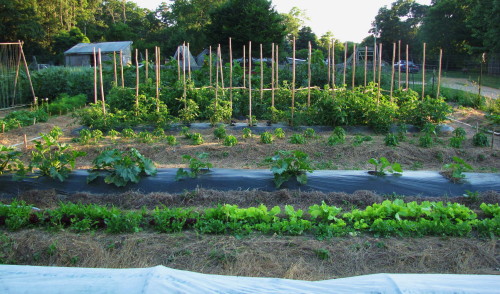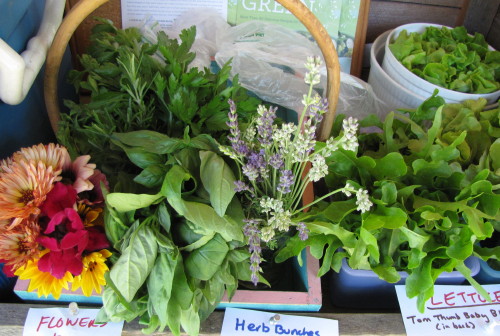I've had vegetable gardens in the past, but this is different. This year, I have a market garden, and I'm selling vegetables at a farm stand. It's supposed to be kind of a part-time gig, but that -- as you can imagine -- is a joke. I thought I just might be able to squeeze the gardening in between writing, cooking, and traveling around to promote my first cookbook this summer. (Fast, Fresh & Green -- a collection of vegetable side dishes -- just went into its third printing!). But with weeding, watering, harvesting, cleaning, stocking the farm stand, re-seeding beds, and chasing after various pests in the garden, it's not really a 25- or 30-percent time suck. More like 50%. It's hard work, and it's tiring. But here's the thing: I love it.

Since this is National Farmers' Market Week, I thought I'd share a little of my first-time growers' experience. I just read that farmers' markets, farm stands, and U-pick operations still (despite a big leap this year) only account for .4 percent of the food economy, so I'm happy to be doing my part (.000001 percent, maybe?) to make local food more available. Better still, I now know what I suspected all along -- that folks who get into small-scale growing are not in it for the money, but for the pleasure of working outdoors and growing their own food -- and a little extra for neighbors, too.
Our plot (I talked my boyfriend into being co-conspirator in this plan) is teeny-tiny by any serious growing standards. It's not even half an acre. But it is large by backyard garden standards (we have 20 75-square-foot beds, and a lot of mulched pathways), so it yields significantly more than our 2.5 person household could eat, especially since we turn the beds over regularly as crops expire. We just replaced the fading peas with basil seedlings; just sowed another crop of bush beans; and we're even trying a second crop of potatoes. Our autumn weather is mild here on Martha's Vineyard, so we'll see what happens. At any rate, the goal is to produce as much as possible to sell at the farm stand.
The garden is actually on the grounds of a working farm, Native Earth Teaching Farm, which has an existing farm stand building right off the road. (Though we are in a fairly remote part of the Island.) The farmer, Rebecca Gilbert, rents small community gardens to Island folks, and kindly agreed to share a bigger plot with us in exchange for a small fee, some labor, and a percentage of whatever we'd sell at the stand. We got an existing garden (complete with deer fence) and water supply -- and a great spot next to the baby goats!
From the outset, my modest goal (or so I thought) was to recoup my initial investment of about $1600. I don't think I'm going to get there, despite an early boost from a $400 grant from the Martha's Vineyard Agricultural Society. Our start-up expenses included growing lights, soil, and plastic trays for starting seedlings indoors this winter; drip hoses, agricultural fabric (row cover) to keep flea beetles off of cruciferious veggies, compost, and hay mulch for the garden; plastic bags and berry boxes for the farm stand; the garden fee; a little bit of lumber for various structures, including a cold frame; and a few tools. We tried to use found materials whenever possible -- all of our trellises are made from bamboo harvested from a friend's property on the Island, we collected seaweed for mulching the lettuces, and we raked (more) hay (who knew so much mulch was needed to keep the weeds down?) from a friend's field. We bought many of our garden tools at yard sales, and we rebuilt a junky old cart that was headed for the dump. But still, little stuff adds up.
Selling at the farm stand has been a trial-and-error sort of thing. I discovered that people like buying lettuce and other salad greens washed and bagged (out of a cooler) better than buying whole heads of pretty lettuce standing fresh in a bowl of water. (I also discovered that arugula is still VERY popular). So I have spent a lot of time picking greens, taking them home and washing and drying them (I had to buy an extra salad-spinner), and cooling them in the fridge. I kept prices pretty low with these spring and summer greens, as I wanted to encourage repeat customers.

As the summer went on, we realized that in our attempt to experiment with a lot of different vegetables, we hadn't planted enough of some easy sellers. Our Red Gold and French Fingerling potatoes were winners, and at $4 and $5 a pound, good money makers. But they're all gone now. My big bunches of fresh baby carrots and pints of shell peas were hits with the young moms and toddlers who were our biggest traffic early on. (They come to see the animals). I could have sold more if I'd had them, for sure.
And then there have been those low-traffic days when we've hardly had a customer--despite a big blackboard sign we made for the road. During these times, I wished I'd had a better marketing plan, or had gone ahead and plunked down the $400 (plus cost of tent) for a booth at one of the smaller farmers' markets for the summer. But in the blink of an eye, traffic would pick back up at the stand, and I would realize that we really weren't growing enough for a farmers' market. (Which of course, would have been an even bigger time commitment, too, and a bigger risk of over-harvesting without selling.)
Now we have a whole different conundrum. It's August on Martha's Vineyard, the President arrives in two weeks, and our annual population has just increased many times over. There are hungry folks (sophisticated city eaters) swarming over every inch of this Island (even up our way), and what do we have? NO tomatoes! We have 40 tomato plants, hundreds, maybe thousands of green tomatoes -- and every kind of pest imaginable conspiring to destroy them before we can harvest them. (This is an organic garden, of course.) The minute the tomatoes turn pinkish, the birds peck them and the worms find them. (Fortunately, some strategies we started a few days ago are already working, and it looks like we'll have Sun Golds for the weekend. But pests, including potato beetles and squash vine-borers, are a real challenge for first-time -- and experienced -- growers.)
It's all about supply and demand. We're getting lots of traffic at the stand this week (the demand), but we don't have quite the supply we need. If all of those tomatoes ripened and made it out to the stand over the next few weeks, it could be possible to make enough money in the month of August to propel us pretty close to our goal. It's funny, but all of the things that affect big growers -- supply & demand, time & money (no grower properly accounts for his or her time -- if at all), the vagaries of nature, and the economies of scale (mid-size may be better than small or big!) -- affect mini-growers, too, just in a less dramatic way.
My boyfriend is quick to point out that we haven't bought a vegetable at the grocery store in months (except for my recipe development ingredients) and that we also did not spend the $400 on a CSA share this year (which, as an aside, was a great value for everything I got over 22 weeks last year.) If you added the value of the food we've harvested from the garden for ourselves onto the ledger, things would look a lot rosier.
But to me the picture looks rosy, anyway. Because the experience of growing those tiny seedlings in out apartment this winter, of watching them take hold in the garden, and of then witnessing them produce the most beautiful array of delicious edibles you could imagine, is irreplaceable. Also, for me--a girl who left her office job because she couldn't stand to be inside all day--the garden is a great relief from the computer. It's a necessary balance for a good life.
Susie Middleton's first cookbook, Fast, Fresh & Green, was published by Chronicle Books in May, 2010.